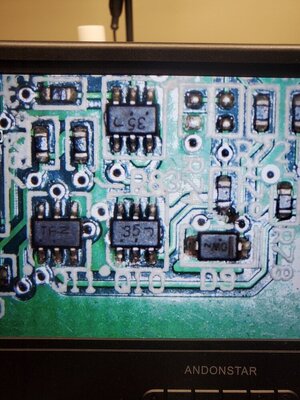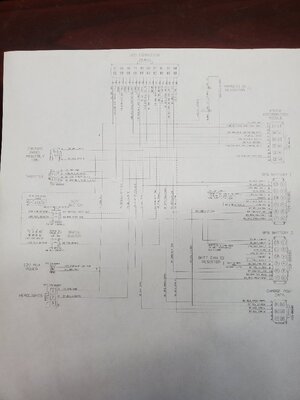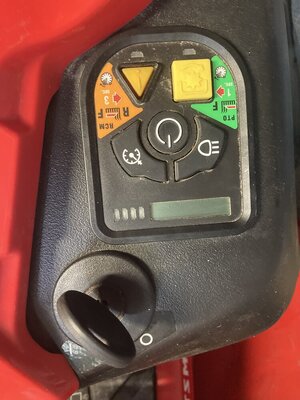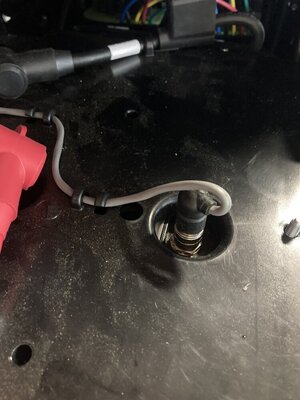odonnse
Well-Known OPE Member
Greetings, fellow yard warriors and electric tractor whisperers.
Let me regale you with the epic saga of my Cub Cadet LT42e, a fine machine that decided it no longer wanted to participate in basic lawn maintenance and instead threw a tantrum in the form of error codes E108, E113, E115, and E116. If this thread helps just one poor soul avoid a mid-mow existential crisis, then my solder burns and sanity loss were not in vain.
Now, a little context: I’m an electrical engineer by trade and run a wiring harness business, so when this thing started speaking in CAN bus riddles, I figured I’d be the one to crack the code. What I didn’t expect was to descend into a rabbit hole so deep, I may now qualify for Cub Cadet’s unofficial electrical engineering team. (Don’t worry, they won’t return my emails either.)
Reaching out to Cub Cadet for support was about as helpful as asking my cat to read a wiring diagram. The good news? This forum came to the rescue like a pit crew at a NASCAR race. Big thanks to the legends here.
After peeling this thing like an electric onion, I discovered the contactor wasn’t closing. Translation: the three motor controllers were basically just very expensive paperweights. Cue dramatic gasp.
Upon further inspection, I found some impressively pinched wires a few inches down from the PDM connector on the main harness. Apparently, Cub Cadet believes in tight wire routing—as in “banjo string” tight. Just enough tension to double as a cheese slicer.
I pulled the PDM and did what any sane person would do: rigged it up on the bench with a 31V power supply, 12V auxiliary, some alligator clips, and sheer stubbornness. It clicked. Lights came on. Birds sang. The Anderson connectors showed voltage. Victory!
Feeling victorious and slightly caffeinated, I yanked the entire main harness to document the pinouts and fix the damage. With the help of old wiring diagrams, a zero-turn troubleshooting guide, and some good ol’ fashioned beep-boop continuity checking, I began to decode the sacred texts of the LT42e.
Here’s where it gets fun (read: maddening). I wanted to see if the VCM was doing its job. So I Frankensteined the harness back together, skipped the non-essentials (sorry, headlights), and began probing like a dentist at a candy convention.
Pin 8? 12V for a few seconds—beautiful. Pin 4? Nada. Zip. Zilch. Suspicion turned to the VCM.
Naturally, I cracked it open like a crab at a seafood boil. Turns out, it's full of tiny little voltage regulators stepping 12V down to 5V and 3.3V—like a Russian nesting doll of disappointment. There’s a microcontroller that should drive 3.3V to a mystery component (my money’s on a transistor), which then activates the coil + and pre-charge signals. Spoiler: mine did not.
I even desoldered this “mystery meat” component, hoping to unlock the secrets of the universe. But no dice. Still no 3.3V. Yet the display works, error codes flow like wine, and other signals are acting normally. So the micro isn’t dead... just moody.
Staring down this VCM like it's an old nemesis in a Western showdown. If anyone has a working VCM they’d be willing to donate to science (or sell for a non-kidney price), I’d be forever grateful. Also, if you have ideas why the VCM might ghost the Coil+ signal, please drop some wisdom.
I managed to pry some fault code info from Cub Cadet’s customer service vault before they slammed the door shut. I attached them in case anyone else is deciphering these hieroglyphics.
Thanks for coming to my TED Talk. May your circuits be sound and your blades sharp.
Let me regale you with the epic saga of my Cub Cadet LT42e, a fine machine that decided it no longer wanted to participate in basic lawn maintenance and instead threw a tantrum in the form of error codes E108, E113, E115, and E116. If this thread helps just one poor soul avoid a mid-mow existential crisis, then my solder burns and sanity loss were not in vain.
Now, a little context: I’m an electrical engineer by trade and run a wiring harness business, so when this thing started speaking in CAN bus riddles, I figured I’d be the one to crack the code. What I didn’t expect was to descend into a rabbit hole so deep, I may now qualify for Cub Cadet’s unofficial electrical engineering team. (Don’t worry, they won’t return my emails either.)
Error Codes & Cub Cadet Support (Or Lack Thereof)
Reaching out to Cub Cadet for support was about as helpful as asking my cat to read a wiring diagram. The good news? This forum came to the rescue like a pit crew at a NASCAR race. Big thanks to the legends here.
Step 1: The Disassembly Olympics
After peeling this thing like an electric onion, I discovered the contactor wasn’t closing. Translation: the three motor controllers were basically just very expensive paperweights. Cue dramatic gasp.
Upon further inspection, I found some impressively pinched wires a few inches down from the PDM connector on the main harness. Apparently, Cub Cadet believes in tight wire routing—as in “banjo string” tight. Just enough tension to double as a cheese slicer.
Step 2: PDM Bench Testing – Mad Scientist Mode
I pulled the PDM and did what any sane person would do: rigged it up on the bench with a 31V power supply, 12V auxiliary, some alligator clips, and sheer stubbornness. It clicked. Lights came on. Birds sang. The Anderson connectors showed voltage. Victory!
Step 3: The Harness Odyssey
Feeling victorious and slightly caffeinated, I yanked the entire main harness to document the pinouts and fix the damage. With the help of old wiring diagrams, a zero-turn troubleshooting guide, and some good ol’ fashioned beep-boop continuity checking, I began to decode the sacred texts of the LT42e.
Step 4: VCM — The Mysterious Black Box of Doom
Here’s where it gets fun (read: maddening). I wanted to see if the VCM was doing its job. So I Frankensteined the harness back together, skipped the non-essentials (sorry, headlights), and began probing like a dentist at a candy convention.
Pin 8? 12V for a few seconds—beautiful. Pin 4? Nada. Zip. Zilch. Suspicion turned to the VCM.
Naturally, I cracked it open like a crab at a seafood boil. Turns out, it's full of tiny little voltage regulators stepping 12V down to 5V and 3.3V—like a Russian nesting doll of disappointment. There’s a microcontroller that should drive 3.3V to a mystery component (my money’s on a transistor), which then activates the coil + and pre-charge signals. Spoiler: mine did not.
I even desoldered this “mystery meat” component, hoping to unlock the secrets of the universe. But no dice. Still no 3.3V. Yet the display works, error codes flow like wine, and other signals are acting normally. So the micro isn’t dead... just moody.
Where I’m At:
Staring down this VCM like it's an old nemesis in a Western showdown. If anyone has a working VCM they’d be willing to donate to science (or sell for a non-kidney price), I’d be forever grateful. Also, if you have ideas why the VCM might ghost the Coil+ signal, please drop some wisdom.
Bonus: Gen 2 VCM Fault Codes
I managed to pry some fault code info from Cub Cadet’s customer service vault before they slammed the door shut. I attached them in case anyone else is deciphering these hieroglyphics.
Thanks for coming to my TED Talk. May your circuits be sound and your blades sharp.











